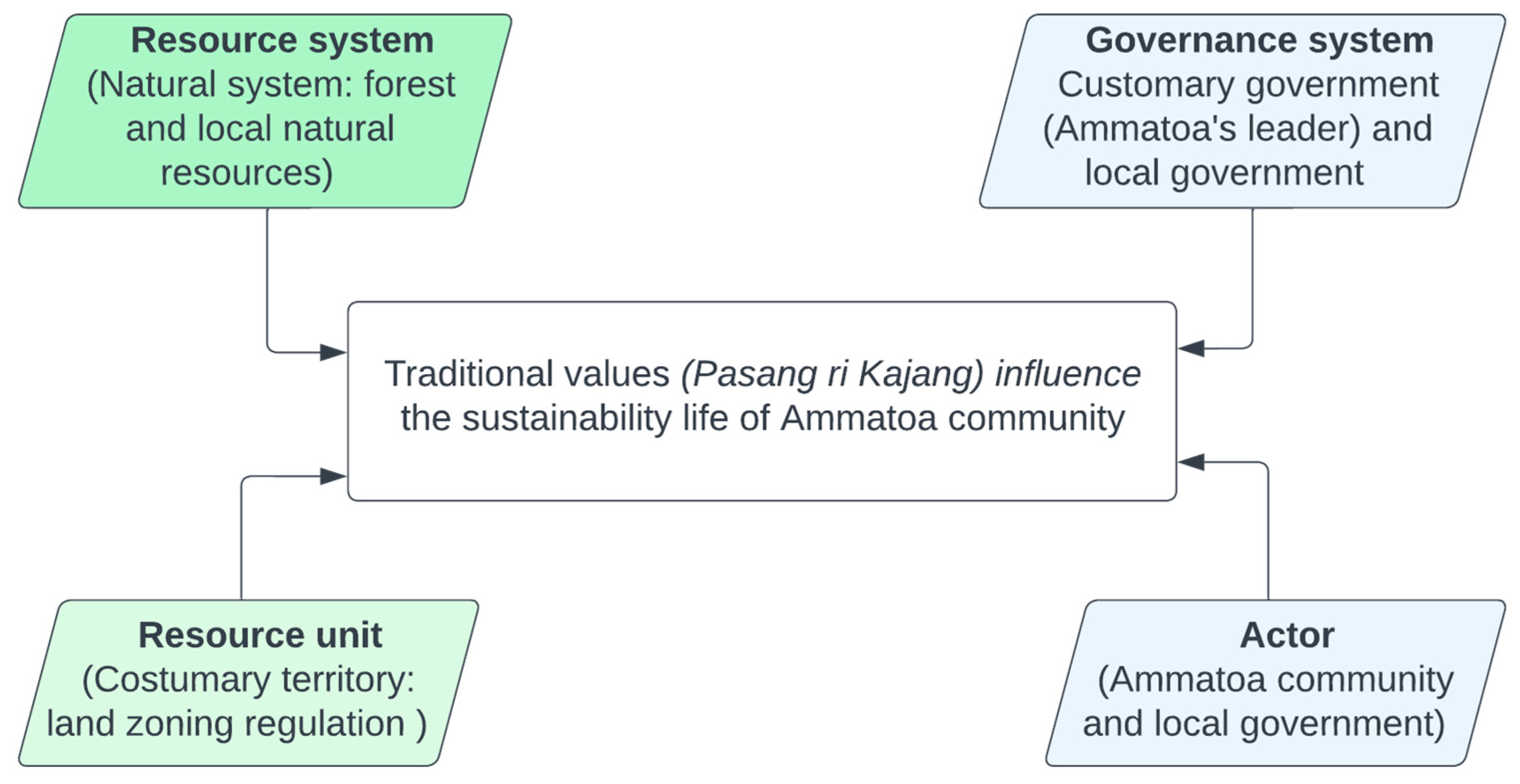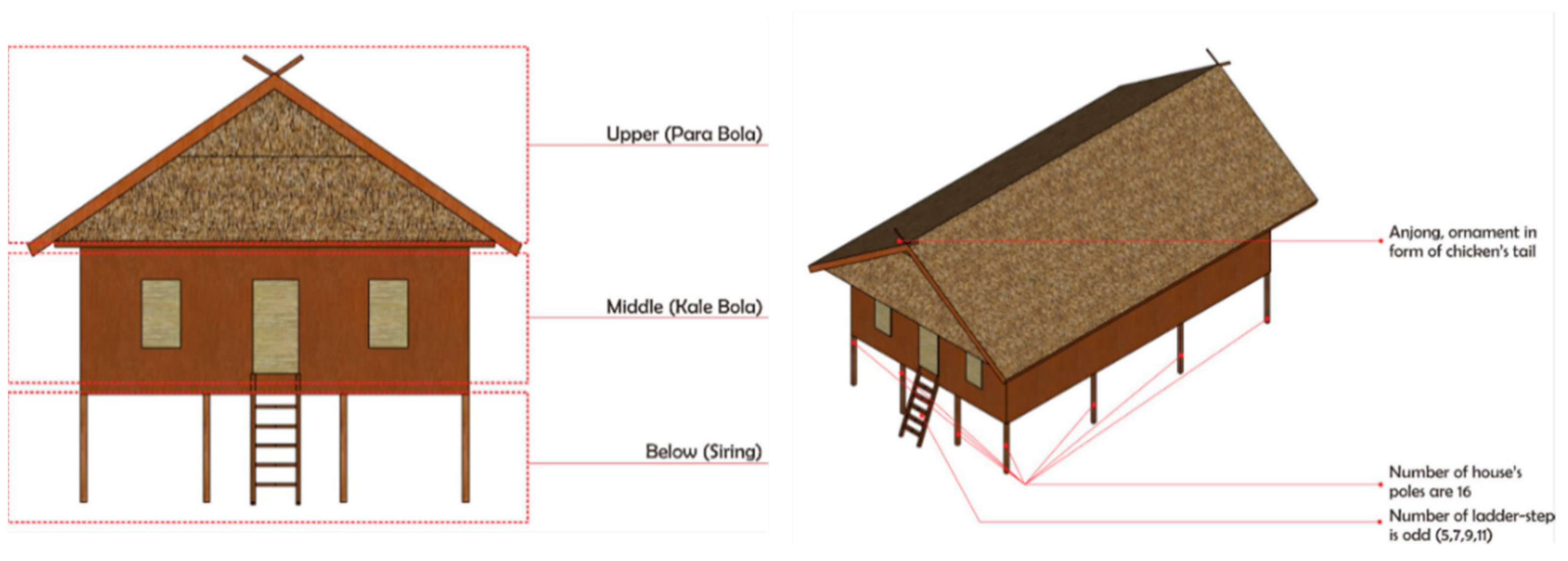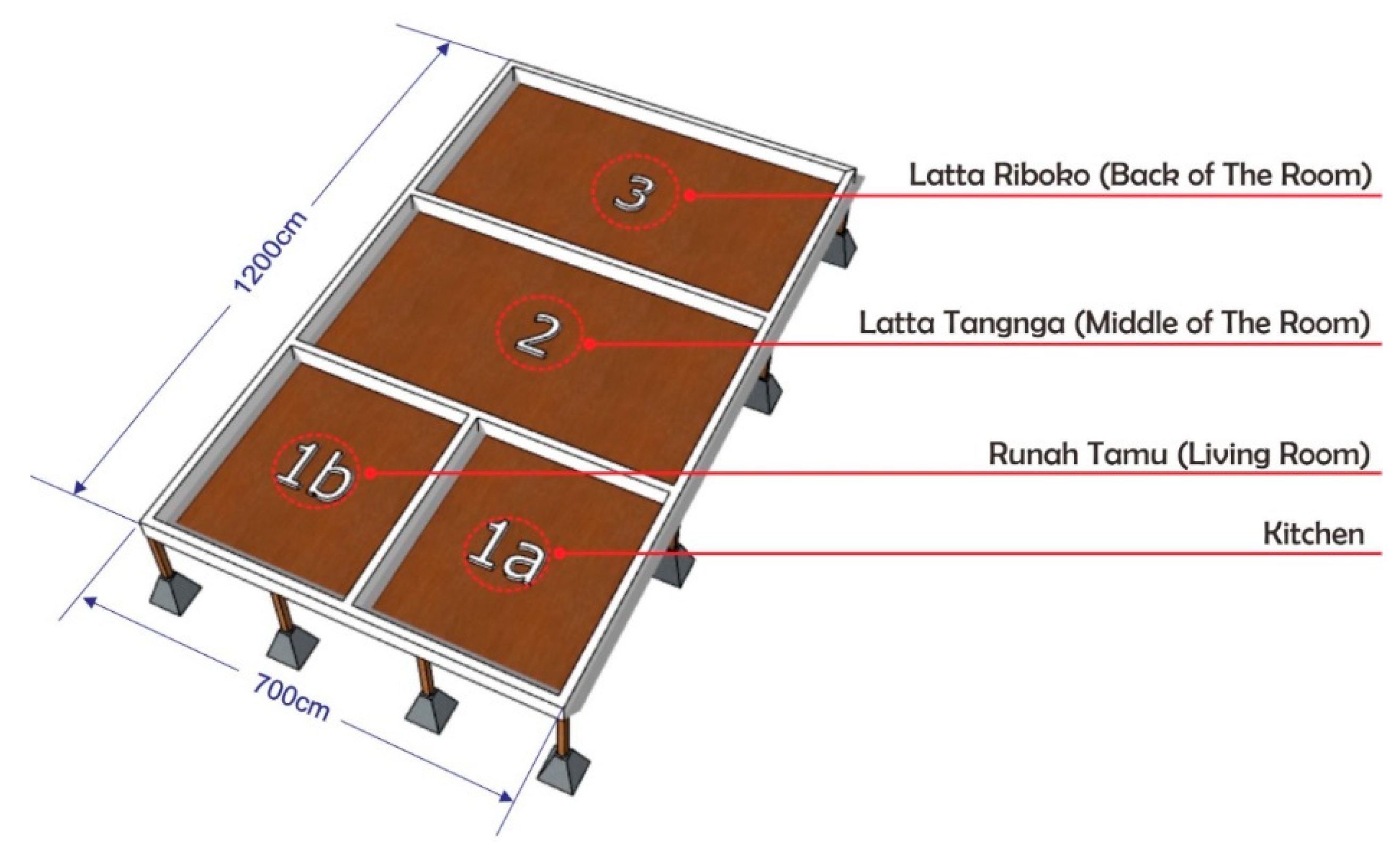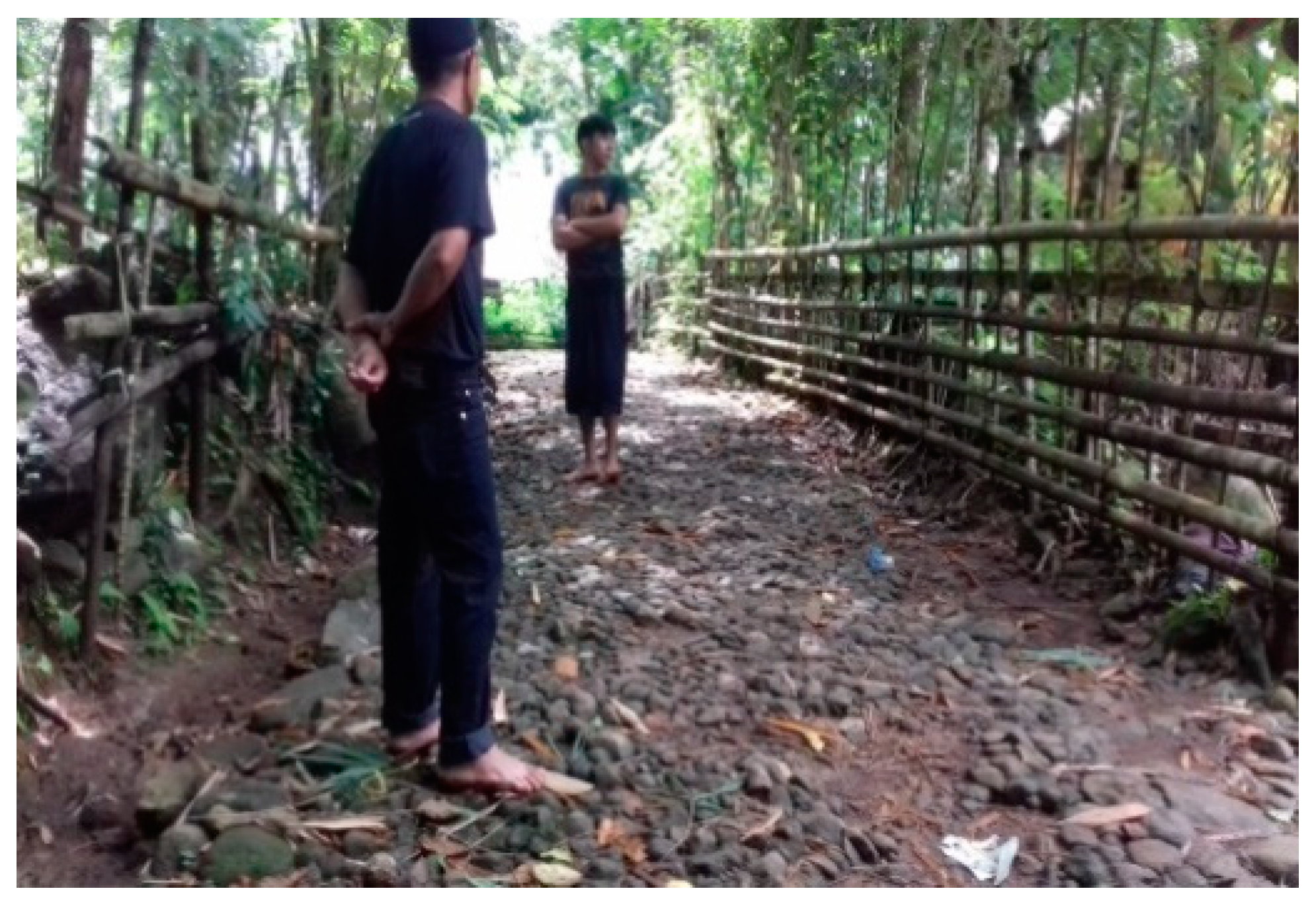To What Extent Does Indigenous Local Knowledge Support the Social–Ecological System? A Case Study of the Ammatoa Community, Indonesia
Abstract
1. Introduction
2. Materials and Methods
3. Results and Discussion
3.1. The Social–Ecological System Framework in the Ammatoa Community
3.2. The Effect of Customary Values on the Way of Life of the Ammatoa Community
3.3. Sustainable Pathway of the Ammatoa Community
3.3.1. Leveraging Local Resources for Livelihood
3.3.2. The Ammatoa Community’s Perception of Shaping Sustainable Settlement
3.4. Conservation and Protected Areas Management
3.5. Lessons Learned from the Local Knowledge of the Ammatoa Community
3.6. Study Limitation and Recommendation for Future Research
4. Conclusions
Author Contributions
Funding
Data Availability Statement
Acknowledgments
Conflicts of Interest
References
- Yiannakou, A.; Eppas, D.; Zeka, D. Spatial interactions between the settlement network, natural landscape and zones of economic activities: Case study in a Greek Region. Sustainability 2017, 9, 1715. [Google Scholar] [CrossRef]
- Partelow, S. A review of the social-ecological systems framework: Applications, methods, modifications, and challenges. Ecol. Soc. 2018, 23, 36. [Google Scholar] [CrossRef]
- Fischer, J.; Gardner, T.A.; Bennett, E.M.; Balvanera, P.; Biggs, R.; Carpenter, S.; Daw, T.; Folke, C.; Hill, R.; Hughes, T.P.; et al. Advancing sustainability through mainstreaming a social-ecological systems perspective. Curr. Opin. Environ. Sustain. 2015, 14, 144–149. [Google Scholar] [CrossRef]
- Berkes, F.; Colding, J.; Folke, C. Rediscovery of traditional ecological knowledge as adaptive management. Ecol. Appl. 2000, 10, 1251–1262. [Google Scholar] [CrossRef]
- Williams, P.A.; Sikutshwa, L.; Shackleton, S. Acknowledging indigenous and local knowledge to facilitate collaboration in landscape approaches- lessons from a systematic review. Land 2020, 9, 331. [Google Scholar] [CrossRef]
- UNESCO. The Unesco Expert Meeting on Indigenous Knowledge and Climate Change in Africa; UNESCO: London, UK, 2018. [Google Scholar]
- Daniel, D. Contextual determinants of general household hygiene conditions in rural indonesia. Int. J. Environ. Res. Public Health 2021, 18, 11064. [Google Scholar] [CrossRef]
- Popp, J. How Indigenous Knowledge Advances Modern Science and Technology. The Conversation. 2018. Available online: https://theconversation.com/how-indigenous-knowledge-advances-modern-science-and-technology-89351 (accessed on 27 February 2022).
- Hill, R.; Díaz, S.; Pascual, U.; Stenseke, M.; Molnár, Z.; Van Velden, J. Nature’s contributions to people: Weaving plural perspectives. One Earth 2021, 4, 910–915. [Google Scholar] [CrossRef]
- Burgos-Ayala, A.; Jiménez-Aceituno, A.; Torres-Torres, A.M.; Rozas-Vásquez, D.; Lam, D.P.M. Indigenous and local knowledge in environmental management for human-nature connectedness: A leverage points perspective. Ecosyst. People 2020, 16, 290–303. [Google Scholar] [CrossRef]
- Lin, Y.; Shui, W.; Li, Z.; Huang, S.; Wu, K.; Sun, X.; Liang, J. Green space optimization for rural vitality: Insights for planning and policy. Land Use Policy 2021, 108, 105545. [Google Scholar] [CrossRef]
- Kamila, N.; Wisnu, I.; Endro, W.; Parkinson, M. Perencanaan Sistem Drainase Berwawasan Lingkungan (Ecodrainage). J. Tek. Lingkung. 2016, 22, 63–72. [Google Scholar] [CrossRef]
- Samad, I.D.; Niswaty, R.; Agus, A.A.; Arman, A. Learning Environmental Lessons from Indegenous Ammatoa Kajang to Preserve the Forest. J. Phys. Conf. Ser. 2021, 1899, 012150. [Google Scholar] [CrossRef]
- Surtikanti, H.K.; Syulasmi, A.; Ramdhani, N. Traditional Knowledge of Local Wisdom of Ammatoa Kajang Tribe (South Sulawesi) about Environmental Conservation. J. Phys. Conf. Ser. 2017, 895, 12122. [Google Scholar] [CrossRef]
- Nowak, A.; Tokarczyk, N. Transformations of traditional land use and settlement patterns of Kosarysche Ridge (Chornohora, Western Ukraine). Bull. Geogr. 2014, 24, 191–201. [Google Scholar] [CrossRef]
- Bruchac, M.M. Indigenous Knowledge and Traditional Knowledge. In Encyclopedia of Global Archaeology; Department of Anthropology Papers; Springer: Berlin/Heidelberg, Germany, 2020; pp. 5686–5696. [Google Scholar]
- Daniel, D.; Djohan, D.; Machairas, I.; Pande, S.; Arifin, A.; Al Djono, T.P.; Rietveld, L. Financial, institutional, environmental, technical, and social (FIETS) aspects of water, sanitation, and hygiene conditions in indigenous—Rural Indonesia. BMC Public Health 2021, 21, 1723. [Google Scholar] [CrossRef]
- Gu, H.; Subramanian, S.M. Drivers of change in socio-ecological production landscapes: Implications for better management. Ecol. Soc. 2014, 19, 41. [Google Scholar] [CrossRef]
- Wohling, M. The problem of scale in indigenous knowledge: A perspective from Northern Australia. Ecol. Soc. 2009, 14, 1. [Google Scholar] [CrossRef]
- Azis, S.; Zubaidah, S.; Mahanal, S.; Batoro, J.; Sumitro, S.B. Local knowledge of traditional medicinal plants use and education system on their young of ammatoa kajang tribe in south sulawesi, indonesia. Biodiversitas J. Biol. Divers. 2020, 21, 3989–4002. [Google Scholar]
- Alayasa, J.Y. Building on the Strengths of Indigenous Knowledge to Promote Sustainable Development in Crisis Conditions from the Community Level: The Case of Palestine; Portland State University: Portland, OR, USA, 2012. [Google Scholar]
- Mccarter, J.; Gavin, M.C.; Baereleo, S.; Love, M. The challenges of maintaining indigenous ecological knowledge. Ecol. Soc. 2014, 19, 39. [Google Scholar] [CrossRef]
- Andiarsi, M.K. Sebaran Masyarakat Adat. Katadata.co.id. 2020. Available online: https://katadata.co.id/padjar/infografik/5f8030631f92a/sebaran-masyarakat-adat (accessed on 5 February 2022).
- Berger, D.N.; Bulanin, N.; García-Alix, L.; Jensen, M.W.; Leth, S.; Madsen, E.A.; Mamo, D.; Parelladaa, A.; Rose, G.; Thorsell, S.; et al. The Indigenous World 2021; International Work Group for Indigenous Affairs: Copenhagen, Denmark, 2021. [Google Scholar]
- Musi, S.; Fitriana, F. Pola Komunikasi Ammatoa dalam Melestarikan Kearifan Lokal Melalui Nilai Kamase-Masea di Kajang. Komodifikasi 2019, 7, 257–290. [Google Scholar]
- Chaurasia, N.K.; Pankaj, C. Case study as a research method. Int. J. Inf. Dissem. Technol. 2011, 1, 34–39. [Google Scholar]
- McGinnis, M.D.; Ostrom, E. Social-ecological system framework: Initial changes and continuing challenges. Ecol. Soc. 2014, 19, 30. [Google Scholar] [CrossRef]
- Nurmala, N.; Dassir, M.; Supratman, S. “Pasang”, Knowledge and Implementation of Local Wisdom in The Kajang Traditional Forest Area, South Sulawesi. Pusaka J. Tour. Hosp. Travel Bus. Event 2022, 4, 40–47. [Google Scholar] [CrossRef]
- Hijjang, P. Pasang and Traditional Leadership Ammatoa Indigenous Communities in Forest Resources Management. In Proceedings of the International Conference on Ethics in Governance (ICONEG 2016), Makassar, Indonesia, 19–20 December 2016; Atlantis Press: Paris, France, 2017; pp. 365–369. [Google Scholar] [CrossRef]
- Rusdiansyah, R. Sumur dan Budaya Suku Kajang; Kearifan Lokal Suku Kajang. J. Commer. 2019, 2, 29–35. [Google Scholar]
- Juhannis, H.; Nildawati Habibi Satrianegara, M.F.; Amansyah, M.; Syarifuddin, N. Community beliefs toward causes of illness: Cross cultural studies in Tolotang and Ammatoa Ethnics in Indonesia. Gac. Sanit. 2021, 35, S19–S22. [Google Scholar] [CrossRef] [PubMed]
- United Nations. State of the World’s Indigenous Peoples: Indigenous Peoples’ Access to Health Services; United Nations: San Francisco, CA, USA, 2016; Available online: https://www.un.org/development/desa/indigenouspeoples/wp-content/uploads/sites/19/2018/03/The-State-of-The-Worlds-Indigenous-Peoples-WEB.pdf (accessed on 27 July 2022).
- Azis, S.; Zubaidah, S.; Mahanal, S.; Sulisetijono Sumitro, S.B. The Ammatoa Kajang’s knowledge, attitude, and practice of medicinal plants used for respiratory disorders remedy. AIP Conf. Proc. 2021, 2330, 030034. [Google Scholar]
- Fadila, L.N.; Handoko, A.S.; Uliyah, L.; Yulanty, C.; Tanduru, J.; Syafruddin, P. Badan Registrasi Wilayah Adat (BRWA). 2019. Available online: https://brwa.or.id/assets/image/rujukan/1580800885.pdf (accessed on 27 July 2022).
- Osman, W.W.; Wunas, D.S.; Arifin, M.; Wikantari, R. The Spatial Patterns of Settlement Plateau of The Ammatoa Kajang: Reflection of Local Wisdom. Int. J. Civ. Eng. Technol. 2020, 11, 199–208. [Google Scholar] [CrossRef]
- Arisaputri, S.B.N. Pola Ruang Permukiman Berdasarkan Kearifan Lokal Kawasan Adat Ammatoa Kecamatan Kajang Kabupaten Bulukumba (Settlement Space Pattern Based on Local Wisdom Ammatoa Traditional Areakajang District Bulukumba Regency). Ph.D. Thesis, ITN Malang, Malang, Indonesia, 2018. [Google Scholar]
- Weir, W. Asphalt Adds to Air Pollution, Especially on Hot, Sunny Days. Yale News. 2020. Available online: https://news.yale.edu/2020/09/02/asphalt-adds-air-pollution-especially-hot-sunny-days#:~:text=Yale researchers observed that common,typical temperature and solar conditions (accessed on 20 November 2022).
- Mukhlisa, N. An Overview of Hyigiene and Sanitation from a Socio Antrhopoligacl Perspective on Kajang Ethnic; State Islamic University of Alauddin Makassar: Makasar, Indonesia, 2021. [Google Scholar]
- Kambo, G.A. Local wisdom Pasang ri Kajang as a political power in maintaining indigenous people’s rights. J. Etnogr. Indones. 2021, 6, 265–280. [Google Scholar] [CrossRef]
- Mahbub, M.A.S.; Salman, D.; Malamassam, D.; Dassir, M.; Ibrahim, T.; Hajawa, H. Indigenous and Non-Indigenous Knowledges Dialectics in Management of Kajang Customary Forest, District of Bulukumba, South Sulawesi. Int. J. Sci. Basic Appl. Res. Int. J. Sci. Basic Appl. Res. 2018, 42, 195–204. Available online: http://gssrr.org/index.php?journal=JournalOfBasicAndApplied (accessed on 30 July 2022).
- Akbal, M.; Umar, F. Adat Law-Based in Developing Environment on Forest Management of Ammatoa. Adv. Soc. Sci. Educ. Hum. Res. 2020, 226, 983–987. [Google Scholar]
- Van der Muur, W.; Bedner, A. Traditional Rule As “Modern Governance”: Recognising the Ammatoa Kajang Adat Law Community. Mimb. Huk.—Fak. Huk. Univ. Gadjah Mada 2016, 28, 149. [Google Scholar] [CrossRef]
- Syarif, E.; Fatchan, A.; Sumarmi; Astina, K. Tradition of “Pasang Ri-Kajang” in the Forests Managing in System Mores of “Ammatoa” at District Bulukumba South Sulawesi, Indonesia. Mediterr. J. Soc. Sci. 2016, 7, 325–332. [Google Scholar] [CrossRef]
- Embas, A.R.; Nas, J. Analisis Sistem Pemerintahan Desa Adat Ammatoa Dalam Pelestarian Lingkungan Hidup Di Kecamatan Kajang, Kabupaten Bulukumba. Ilmu Pemerintah. 2017, 10, 30–37. [Google Scholar]
- Imran, K.; Pratama, W.A.; Pratama, W.A. Penguatan Hak-Hak Masyarakat Hukum Adat Ammatoa Kajang Sebagai Wujud Realisasi Putusan Mahkamah Konstitusi Nomor 35/PUU-X/2012. Legislatif 2020, 3, 254–268. [Google Scholar] [CrossRef]
- Maarif, S.; Azis, A.; Setiani, P. Pembangunan nasional: Kearifan lokal sebagai sarana dan target community building untuk komunitas Ammatoa. Masy. Kebud. Dan Polit. 2013, 26, 167–181. [Google Scholar]
- Hijjang, P. Pasang dan Kepemimpinan Ammatoa: Memahami Kembali Sistem Kepemimpinan Tradisional Masyarakat Adat dalam Pengelolaan Sumberdaya Hutan di Kajang Sulawesi Selatan. Antropol. Indones. 2014, 29, 255–268. [Google Scholar] [CrossRef]
- Sayer, J.; Sheil, D.; Galloway, G.; Riggs, R.A.; Mewett, G.; MacDicken, K.G.; Arts, B.; Boedhihartono, A.K.; Langston, J.; Edwards, D.P.; et al. SDG 15: Life on land-The central role of forests in sustainable development. In Sustainable Development Goals: Their Impacts on Forests and People; Cambridge University Press: Cambridge, UK, 2019; pp. 482–509. [Google Scholar]
- Schiffman, R. Lessons Learned from Centuries of Indigenous Forest Management. YaleEnvironment360. 2018. Available online: https://e360.yale.edu/features/lessons-learned-from-centuries-of-indigenous-forest-management (accessed on 4 October 2022).
- Ridhwan, D.; Astri, C.; Taufik, A.A.; Affandi, D.; Fajar, M.; Lawalata, J. Improving the Lives of Indigenous Communities through Mapping: A Case Study from Indonesia. WRI Indones. 2020. [Google Scholar] [CrossRef]
- Kissinger, M.; Sussman, C.; Moore, J.; Rees, W.E. Accounting for the ecological footprint of materials in consumer goods at the urban scale. Sustainability 2013, 5, 1960–1973. [Google Scholar] [CrossRef]
- Richardson, R.B. Yes, Humans Are Depleting Earth’s Resources, but ‘Footprint’ Estimates Don’t Tell the Full Story. The Conversation. 2018. Available online: https://theconversation.com/yes-humans-are-depleting-earths-resources-but-footprint-estimates-dont-tell-the-full-story-100705 (accessed on 2 March 2022).
- Hill, R.; Malmer, P.; Raymond, C.M.; Spierenburg, M.; Danielsen, F.; Elmqvist, T.; Folke, C. Weaving knowledge systems in IPBES, CBD and beyond—Lessons learned for sustainability. Curr. Opin. Environ. Sustain. 2016, 26–27, 17–25. [Google Scholar] [CrossRef]






| No. | Aspect | Pasang ri Kajang | Meaning | Interpretation Related to Common Scientific Knowledge |
|---|---|---|---|---|
| 1 | Forest conservation | Punna nita’bangi kajua boronga ri. Bosi anggurangi appakaanre’i timbusu. Anjo boronga angngontaki bosiya. Aka’na kajua appakalompo tumbusu. | If a tree fell in the forest, then it will reduce rainfall, eliminating springs. It is the forests that bring rain, tree roots enhance the springs. | Forest conservation can deal with climate change, prevent flooding, and protect water resources. Forests and trees greatly contribute to maintaining the water cycle. Water is absorbed and then flows to the leaves through tree roots, evaporates, and is released into the atmosphere. When trees are cut down, the area becomes arid, and there is nothing to help the soil absorb more water. The loss of soil absorption will impact the dry season, wherein there are no more water reserves that should be used during the dry season. It is because the trees that act as a reservoir for groundwater reserves are no longer available, so this will impact the occurrence of a prolonged drought and will also lead to a decrease in water resources. In other words, protecting forests means protecting life and resources, especially water which is a basic need not only for domestic needs but also for industries that support human needs. |
| 2 | Sustainability Concepts | Punna nitabbangngi kayua, nipappirangngangngi angngurangi bosi, appatanre’ tumbusu, napau turiolowa | Sustainability in customary areas includes environmental, social, and economic systems arranged and interconnected. The existence of binding rules can foster a wise attitude in meeting economic needs, while maintaining environmental sustainability. The Ammatoa community believes that logging or overexploitation will disrupt the natural cycle and bring disaster. | The sustainability principle adopted by the Ammatoa community teaches to always act wisely towards the environment and resources. They use existing natural resources without overexploiting and based on customary rules. Basically, their principle has been attempted to implement a sustainable development paradigm that pays attention to economic, social, and environmental aspects. Economic activities should not always be faced with environmental and resource damage. With ways that are more sustainable, people can pay attention to consumption patterns and they will maintain the balance of the three components of sustainability. |
| 3 | Land arrangement | Punna donro koko, punna lappara galung | Landowners have the right to regulate the use of their land in customary areas. However, they must still be guided by customary rules in their management. Land use is adjusted to the physical conditions of the landscape. Hilly land must be suitable for plantations or agriculture, while flat land is intended for rice fields. | Land use planning is necessary to ensure that the environment’s carrying capacity is maintained. The Ammatoa community has arranged their land based on the geographical and physical conditions of the area, so that they can use the land according to its capabilities or characteristics. In line with customary values, considering the importance of space utilization, the Indonesian government has regulated spatial planning at the national, provincial, district and city levels. The spatial plan regulates money polarity and stipulates land use for cultivation and protected areas. |
| 4 | Building orientation | Naiya bolaya di tana kamase-masea tanakulle nadalleki borong karasayya, tanakulle nadalleki allu mannyallukia, naiya kulle dihoja passiringangnga | Settlements in customary areas must pay attention to the direction of their placement and not face sacred places, sacred forests, and deep valleys. | Regulations on the orientation of buildings outside the customary area are not related to traditional beliefs. However, the orientation of buildings to the science of architecture has been associated with natural lighting and natural ventilation. So, it is important to pay attention to the orientation of the building because it is related to thermal comfort. The optimum building orientation in all climatic areas is elongated from east to west. In addition, the orientation of the building to the wind direction needs to be considered. It aims to maintain the stability of the wind circulation in the building. Wind direction is very influential on the orientation of the building. In humid areas, continuous air circulation is required. In dry areas, air circulation is usually used only when needed, such as cold or at night. Adjusting the orientation of the building will contribute to energy savings (i.e., minimizing the use of lights and air conditioners) due to proper lighting and thermal regulation. |
| 5 | Modernity and lifestyle | Punna a’rakko conde takkeke cinde tarimba-rimba ba’leang tuliko rangngang doro laukang limba | The concept of tau kamase-masea (“the modest man” in English) is embedded in the Ammatoa community, so that the settlement facilities and infrastructure regulated by custom are considered adequate. Enjoying luxury and modernization must be outside the customs territory. | The rejection of modernity cannot be applied outside the Ammatoa Area. Heterogeneous human activities, rapid mobility, and the development of information technology require humans to be connected to the infrastructure considered modern by the Ammatoa community (e.g., road network, internet network, and electricity network). However, another value that can be noticed from the Ammatoa community’s rejection of modernity is that the materials used in constructing the infrastructure must be environmentally friendly. |
Publisher’s Note: MDPI stays neutral with regard to jurisdictional claims in published maps and institutional affiliations. |
© 2022 by the authors. Licensee MDPI, Basel, Switzerland. This article is an open access article distributed under the terms and conditions of the Creative Commons Attribution (CC BY) license (https://creativecommons.org/licenses/by/4.0/).
Share and Cite
Daniel, D.; Satriani, S.; Zudi, S.L.; Ekka, A. To What Extent Does Indigenous Local Knowledge Support the Social–Ecological System? A Case Study of the Ammatoa Community, Indonesia. Resources 2022, 11, 106. https://doi.org/10.3390/resources11120106
Daniel D, Satriani S, Zudi SL, Ekka A. To What Extent Does Indigenous Local Knowledge Support the Social–Ecological System? A Case Study of the Ammatoa Community, Indonesia. Resources. 2022; 11(12):106. https://doi.org/10.3390/resources11120106
Chicago/Turabian StyleDaniel, D., S. Satriani, Sefriyani Lea Zudi, and Anjana Ekka. 2022. "To What Extent Does Indigenous Local Knowledge Support the Social–Ecological System? A Case Study of the Ammatoa Community, Indonesia" Resources 11, no. 12: 106. https://doi.org/10.3390/resources11120106
APA StyleDaniel, D., Satriani, S., Zudi, S. L., & Ekka, A. (2022). To What Extent Does Indigenous Local Knowledge Support the Social–Ecological System? A Case Study of the Ammatoa Community, Indonesia. Resources, 11(12), 106. https://doi.org/10.3390/resources11120106










